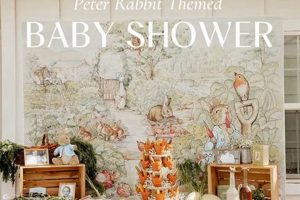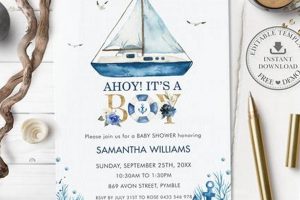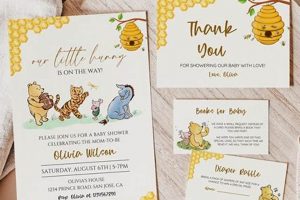The focus of this exposition is on the concept of party designs that are suitable for celebrating the impending arrival of a child, regardless of the baby’s sex. These celebrations offer a departure from traditional pink-for-girls and blue-for-boys motifs. Examples range from nature-inspired gatherings utilizing neutral color palettes to storybook-themed events centered around beloved children’s literature.
Such a design approach provides several advantages. It simplifies planning, especially when the baby’s sex is unknown or when the parents prefer not to reinforce societal gender norms. Furthermore, it allows for greater creativity in decorations and gifts, expanding beyond the limited scope of traditional options. Historically, these celebrations have gained traction as awareness of gender stereotypes has increased.
The subsequent sections will delve into specific options for creating memorable, inclusive, and aesthetically pleasing celebrations for expectant parents, showcasing ideas that move beyond conventional biases.
Guidance for Inclusive Baby Celebrations
The following recommendations provide practical guidance for planning celebrations that are inclusive and aesthetically pleasing, while avoiding reliance on gender-specific stereotypes.
Tip 1: Select a Neutral Color Palette: Opt for colors like greens, yellows, grays, whites, or earth tones to create a calming and versatile atmosphere. These palettes work well with various themes and are suitable for either sex.
Tip 2: Embrace Nature-Inspired Designs: Incorporate elements such as plants, woodland creatures, or a garden motif. These themes are inherently gender-neutral and can be visually appealing.
Tip 3: Choose a Storybook Theme: Center the celebration around a beloved children’s book with universal appeal. This provides a cohesive design element and offers opportunities for creative decorations and activities.
Tip 4: Focus on Geometric Patterns: Utilize patterns like stripes, polka dots, or chevrons in neutral colors. These designs are visually interesting without being gender-specific.
Tip 5: Opt for Animal Themes: Feature animals such as jungle animals, farm animals, or safari animals. These themes are inherently neutral and offer opportunities for creative decorations and activities.
Tip 6: Consider a Travel or Adventure Theme: Use maps, globes, or airplane motifs to celebrate the adventure of parenthood. This theme is suitable for any baby, regardless of sex.
Tip 7: Incorporate DIY Elements: Create personalized decorations and favors to add a unique touch. Handmade items can be tailored to suit any theme and are often more meaningful.
These suggestions provide a foundation for crafting celebrations that are both thoughtful and visually appealing, while avoiding the limitations of traditional gender-based designs. By focusing on inclusivity and creativity, the celebration can be more enjoyable for all attendees.
The subsequent section will provide additional information to support the planning and execution of memorable and inclusive baby celebrations.
1. Neutral Color Palettes
In the context of celebrations focused on welcoming a new child, the selection of a neutral color palette serves as a foundational element in avoiding gender-based stereotypes and fostering inclusivity. The strategic use of color directly influences the ambiance and messaging of the event.
- Defining Neutrality
Neutral colors encompass a range of hues that are not traditionally associated with either sex. These typically include shades of white, beige, gray, green, yellow, and brown. The use of these colors mitigates the risk of reinforcing pre-conceived notions about gender roles and expectations. For example, a backdrop of soft gray with accents of muted gold can create an elegant atmosphere suitable for any child.
- Psychological Impact
Colors have a direct psychological effect on individuals. Traditional pink and blue can immediately trigger associations with specific sexes, potentially influencing perceptions and expectations. A neutral palette allows for a blank canvas, encouraging attendees to focus on the broader celebration of new life rather than gendered assumptions. Research in color psychology supports the notion that neutral tones promote calmness and objectivity.
- Versatility in Theme Development
A neutral base color scheme provides exceptional versatility when developing a theme. Whether the theme is nature-inspired, animal-focused, or centered around a favorite story, neutral colors can be seamlessly integrated. Consider a woodland theme using various shades of green and brown, or a safari theme incorporating beige and tan. These themes lend themselves to creative decorations and activities that are not confined by gender norms.
- Long-Term Reusability
Decorations and supplies purchased in neutral colors can often be reused for future events or repurposed within the home. This contrasts with gender-specific items that may become obsolete or irrelevant as the child grows. Investing in neutral-toned items represents a more sustainable and practical approach to celebration planning. For example, neutral-colored banners and tablecloths can be stored and used for other occasions.
The integration of a neutral color palette into celebrations contributes significantly to the creation of an inclusive and welcoming environment. By consciously avoiding gender-specific hues, event planners can shift the focus towards celebrating the arrival of a new baby, regardless of societal expectations. The choice of color, therefore, becomes a powerful tool in shaping perceptions and promoting equality.
2. Inclusive Activity Planning
Thoughtful activity selection is crucial for establishing a welcoming and equitable environment at a baby shower that moves beyond traditional gendered expectations. The aim is to design entertainment options that engage all guests, regardless of their relationship to the expectant parents or their personal views on gender roles.
- Games That Encourage Collaboration
Activities should prioritize teamwork and shared experience over individual competition, avoiding topics that might be divisive or exclusionary. Examples include collaborative art projects, where guests contribute to a mural for the baby’s room, or team-based trivia games focusing on parenting knowledge and general facts, rather than gendered assumptions about child-rearing. Success depends on cooperative effort and shared knowledge, thus fostering a sense of unity.
- Craft Stations with Neutral Materials
Providing a variety of craft supplies in neutral colors enables guests to create personalized items for the baby without imposing gendered stereotypes. Options might include decorating wooden blocks, personalizing cloth diapers with fabric markers, or assembling baby mobiles using non-gendered imagery. This allows for creative expression and personal contribution, fostering a sense of involvement and usefulness.
- Activities that Focus on Knowledge and Support
Instead of traditional games based on gendered assumptions about babies, the focus should be on sharing practical knowledge and offering support to the expectant parents. Examples include a station where guests write advice cards on parenting, a discussion forum for sharing experiences and tips, or a collaborative brainstorming session to generate ideas for baby names. This promotes useful information and reinforces a sense of community.
- Eliminating Gendered Prizes and Language
Prizes should be chosen without regard to gender, and language used throughout the activities must be inclusive and respectful of all participants. Instead of awarding traditionally gendered items, consider offering gift cards, spa treatments, or gourmet food baskets. Furthermore, use inclusive language that avoids assumptions about gender roles, parenthood, and family structures, ensuring everyone feels welcome and valued.
In essence, planning inclusive activities for a baby shower centered around the concept of sex neutrality necessitates a mindful approach that prioritizes collaboration, creativity, knowledge-sharing, and respect. By carefully curating activities that move beyond conventional gender roles and expectations, the event can become a truly welcoming and celebratory experience for all involved, promoting a sense of unity and support for the expectant parents.
3. Versatile Decoration Options
The successful execution of celebrations centered around an infants impending arrival, irrespective of sex, hinges significantly on decoration choices that are adaptable and inclusive. The availability of diverse decorating possibilities directly facilitates the avoidance of gender stereotypes and the creation of an atmosphere that celebrates new life without biases. Cause and effect are evident: the wider the array of available decorating options, the easier it becomes to sidestep traditional gender-based themes. The significance of versatile decoration options is paramount as they fundamentally contribute to the aesthetic representation of the neutral theme. For instance, balloon arches using a spectrum of pastel colors, from lavender to mint green to sunny yellow, offer a festive atmosphere without prescribing to conventional color coding. Similarly, a jungle-themed shower can utilize lush greenery, stuffed animals representing various species, and burlap accents, achieving a visually appealing design devoid of gendered undertones.
Practical applications extend to selecting reusable and multipurpose dcor items. Investing in decorations that can be repurposed for subsequent events or within the child’s nursery contributes to both financial efficiency and environmental sustainability. For example, fabric banners featuring geometric patterns or abstract designs can be hung in the nursery post-celebration. Mason jars adorned with twine and used as centerpieces can later serve as storage containers. This approach enhances the value of the decorations beyond the immediate event.
In summary, versatile decoration options serve as a cornerstone of successful neutral celebrations. By carefully selecting decorations that are adaptable, inclusive, and potentially reusable, event planners can cultivate an atmosphere that genuinely celebrates the anticipated arrival of a new infant, devoid of restrictive stereotypes. Overcoming the challenge of sourcing diverse and high-quality decorations involves researching retailers specializing in event supplies and exploring DIY opportunities to personalize the decorations according to the parents’ preferences, aligning with the overarching goal of inclusive celebration planning.
4. Gift Registry Considerations
Gift registry management constitutes an integral component in the planning of a baby shower characterized by sex neutrality, ensuring alignment with the thematic intention to avoid gender-based stereotypes. The effective curation of a gift registry supports the inclusive nature of the celebration, guiding attendees toward suitable and practical gifts.
- Prioritizing Practical and Essential Items
A carefully constructed gift registry prioritizes items essential for infant care and development, irrespective of the child’s sex. Examples encompass items like clothing in neutral colors, feeding supplies, diapers, and nursery furniture. This approach directs guests toward selecting gifts that address practical needs rather than adhering to gender-specific expectations. The implications are twofold: parents receive items they genuinely require, and the celebration avoids reinforcing gender stereotypes.
- Including Open-Ended Toy Options
The registry should feature toys and developmental tools that encourage open-ended play and creativity, rather than those traditionally marketed towards a specific sex. Examples include building blocks, art supplies, musical instruments, and books featuring diverse characters and themes. This promotes intellectual and emotional development while challenging restrictive gender norms. The impact is that the child is exposed to a wide range of experiences and possibilities from an early age.
- Specifying Preferences for Neutral Designs
The registry offers the opportunity to explicitly communicate preferences for neutral designs and color palettes. This can be achieved through detailed descriptions of desired items or by including links to specific products that align with the aesthetic vision. This empowers parents to curate a collection of items that reflect their values and avoid perpetuating gendered marketing tactics. The outcome is a cohesive and intentional design scheme for the nursery and early childhood.
- Considering Alternatives to Traditional Gifts
The registry can extend beyond physical items to include alternative options that support the family’s well-being. Examples are contributions to a college fund, donations to a charitable organization in the baby’s name, or offers of practical assistance, such as meal preparation or babysitting services. This promotes a holistic approach to supporting the family and challenges the consumerist focus often associated with baby showers. The result is a more meaningful and impactful celebration.
Collectively, thoughtful gift registry considerations are paramount for ensuring the successful execution of a baby shower that embraces sex neutrality. By prioritizing practical items, open-ended toys, neutral designs, and alternative gift options, the registry guides attendees toward contributions that genuinely support the family and promote inclusive values, fostering a celebration centered on the joy of new life rather than adherence to traditional gender stereotypes.
5. Theme Adaptability
Theme adaptability is a critical component of a successful sex-neutral baby shower. The ability to modify and tailor a theme ensures that the celebration avoids gender stereotypes and resonates with the expectant parents’ preferences. A rigid, gender-specific theme undermines the core principle of inclusivity that a sex-neutral baby shower aims to achieve. For example, a “travel” theme can easily be adapted by focusing on maps, globes, and modes of transportation without specifying gendered destinations or activities. Similarly, a “storybook” theme can feature stories with strong, diverse characters of all sexes, avoiding narratives that reinforce traditional gender roles. The significance of theme adaptability lies in its capacity to transform potentially gendered concepts into universally appealing celebrations.
Practical applications of theme adaptability extend to decorations, activities, and favors. A “woodland” theme, if not carefully planned, could lean towards traditionally feminine or masculine elements. However, by focusing on neutral aspects such as various types of trees, forest animals applicable to both sexes (owls, deer, squirrels), and using a palette of greens, browns, and creams, the theme maintains its neutrality. Regarding activities, instead of games that might reinforce gendered expectations, interactive experiences such as building a birdhouse or planting a tree sapling can be incorporated. Favors, such as small bags of wildflower seeds or personalized wooden ornaments, reinforce the chosen theme without specifying gender.
In conclusion, theme adaptability is not merely a desirable trait but a fundamental requirement for effective sex-neutral baby shower planning. Challenges in achieving this adaptability can arise from ingrained societal expectations and marketing practices that often categorize themes along gender lines. Overcoming these challenges necessitates conscious effort, careful planning, and a commitment to celebrating the impending arrival of a new child in a way that is both inclusive and meaningful. Successfully employing theme adaptability ensures that the celebration centers on the shared joy of welcoming a new life, free from restrictive gender stereotypes.
6. Celebration Purpose
The underlying motivation for hosting a gathering dedicated to an expectant family provides a framework that directly influences the selection and execution of design elements, especially when aiming for a party design that is suitable for any baby. Aligning the event’s overarching intent with the chosen design is crucial for creating a cohesive and meaningful experience.
- Focusing on Parental Support
One primary aim is to offer tangible and emotional support to the parents-to-be. If the celebration’s goal is to equip them for the challenges of parenthood, gift-giving can be directed toward practical necessities rather than gendered items. Activities can revolve around sharing advice and offering assistance with childcare or household tasks. For instance, a diaper-folding demonstration, a station for creating freezer meals, or a sign-up sheet for post-partum support all underscore this purpose while remaining thematically aligned with a design appropriate for either sex.
- Celebrating New Life, Not Gender
When the central aim is to commemorate the anticipation of new life rather than predetermine characteristics based on the baby’s sex, a conscious effort is made to avoid gender-specific imagery and messaging. Decorations, games, and even food choices can reflect a broader appreciation for the miracle of birth and the expansion of a family. Examples include using nature-inspired decorations, featuring animals that are not culturally gendered, or selecting storybooks that promote universal values and diverse representation.
- Promoting Inclusivity and Equality
If the celebration aims to actively challenge gender stereotypes and promote equality, the design can serve as a platform for these values. Activities might encourage discussions about gender roles in parenting, and gifts can be selected to support the child’s development regardless of their sex. For instance, including books that subvert traditional gender roles or providing opportunities for guests to donate to organizations that support gender equality underscores this purpose while adhering to design principles that move beyond conventional norms.
- Creating a Joyful and Memorable Experience
Regardless of other specific aims, creating a positive and lasting memory for the expectant family and their loved ones is a common underlying goal. This involves ensuring that the event is well-organized, engaging, and emotionally resonant. The design contributes to this by creating a visually appealing and comfortable atmosphere where guests feel welcome and celebrated. Examples include personalized decorations that reflect the parents’ personalities, thoughtful favors that express gratitude, and activities that promote laughter and connection.
The explicit articulation and conscious consideration of the intended purpose for the baby shower directly influence the choice of design elements, enabling a cohesive and meaningful celebration that transcends traditional gender expectations. By aligning the celebration’s core values with design choices, the event becomes a powerful expression of support, joy, and inclusivity, honoring the arrival of a new child and the beginning of a family’s journey.
Frequently Asked Questions About Celebrations Suitable for Any Baby
The subsequent section addresses common inquiries regarding planning baby showers that are deliberately designed to avoid gender-specific themes, fostering inclusivity and creative expression.
Question 1: What are the primary benefits of selecting a celebration design that is suitable for any baby?
Selecting party designs unlinked to a specific sex offers multiple advantages, including simplified planning, especially when the baby’s sex is unknown or the parents desire to avoid gender stereotypes. Additionally, such designs allow for greater creativity in decorations and gifts.
Question 2: How does the use of neutral colors contribute to a celebration design that is suitable for any baby?
Neutral color palettes, comprising hues like greens, yellows, grays, whites, and earth tones, create a calming and versatile atmosphere, serving as a blank canvas for diverse thematic elements without imposing gendered expectations.
Question 3: What types of activities are appropriate for celebrations focused on the arrival of an infant that steer clear of gendered assumptions?
Suitable activities emphasize collaboration, knowledge-sharing, and creativity, avoiding games or discussions that might reinforce traditional gender roles. Examples include collaborative art projects, trivia focused on general parenting knowledge, and advice-sharing sessions.
Question 4: How can a gift registry support the intent of a celebration that is suitable for any baby?
A carefully curated registry should prioritize practical items like diapers, clothing in neutral colors, and essential nursery furnishings, while also including open-ended toys and developmental tools that encourage creativity and exploration regardless of sex.
Question 5: How can a theme be effectively adapted to ensure it remains suitable for any baby?
Theme adaptability involves focusing on neutral elements within a chosen theme. For example, a travel theme could emphasize maps and modes of transportation rather than destinations stereotypically associated with either sex. A storybook theme should feature books with diverse characters and universal values.
Question 6: What is the overarching purpose of hosting a celebration design that is suitable for any baby, and how does this purpose influence planning decisions?
The overarching purpose is to celebrate new life and support the expectant parents, avoiding gender stereotypes. This purpose guides decisions regarding decorations, activities, gifts, and overall event design, ensuring alignment with inclusive values.
In summary, planning such celebrations requires thoughtful consideration of color palettes, activities, gift registries, and theme adaptability. The primary goal is to create a welcoming and joyful event that supports the family and celebrates the impending arrival of a new child in a manner free from restrictive stereotypes.
The subsequent section provides concluding remarks on the benefits of planning celebrations suitable for all babies.
Conclusion
The preceding exploration underscores the importance of “unisex baby shower themes” in modern celebrations. By embracing neutral color palettes, adaptable thematic elements, and inclusive activities, planners create events that prioritize the expectant parents and the forthcoming child, transcending societal biases. The conscious avoidance of gender stereotypes fosters an environment of inclusivity, allowing attendees to focus on the joy of new life rather than preconceived notions.
Ultimately, the selection of “unisex baby shower themes” represents a deliberate choice to challenge traditional norms and promote equality from the outset. Embracing these design approaches can contribute to a more equitable and affirming future for children, where opportunities and expectations are not limited by gender. Continued consideration of these principles in event planning serves as a positive step toward a more inclusive society.



![Baby Shower Etiquette: Does Mom-To-Be Pay? [Explained] Baby Care 101: Essential Tips for Happy, Healthy Babies Baby Shower Etiquette: Does Mom-To-Be Pay? [Explained] | Baby Care 101: Essential Tips for Happy, Healthy Babies](https://singlebabies.com/wp-content/uploads/2025/10/th-971-300x200.jpg)



